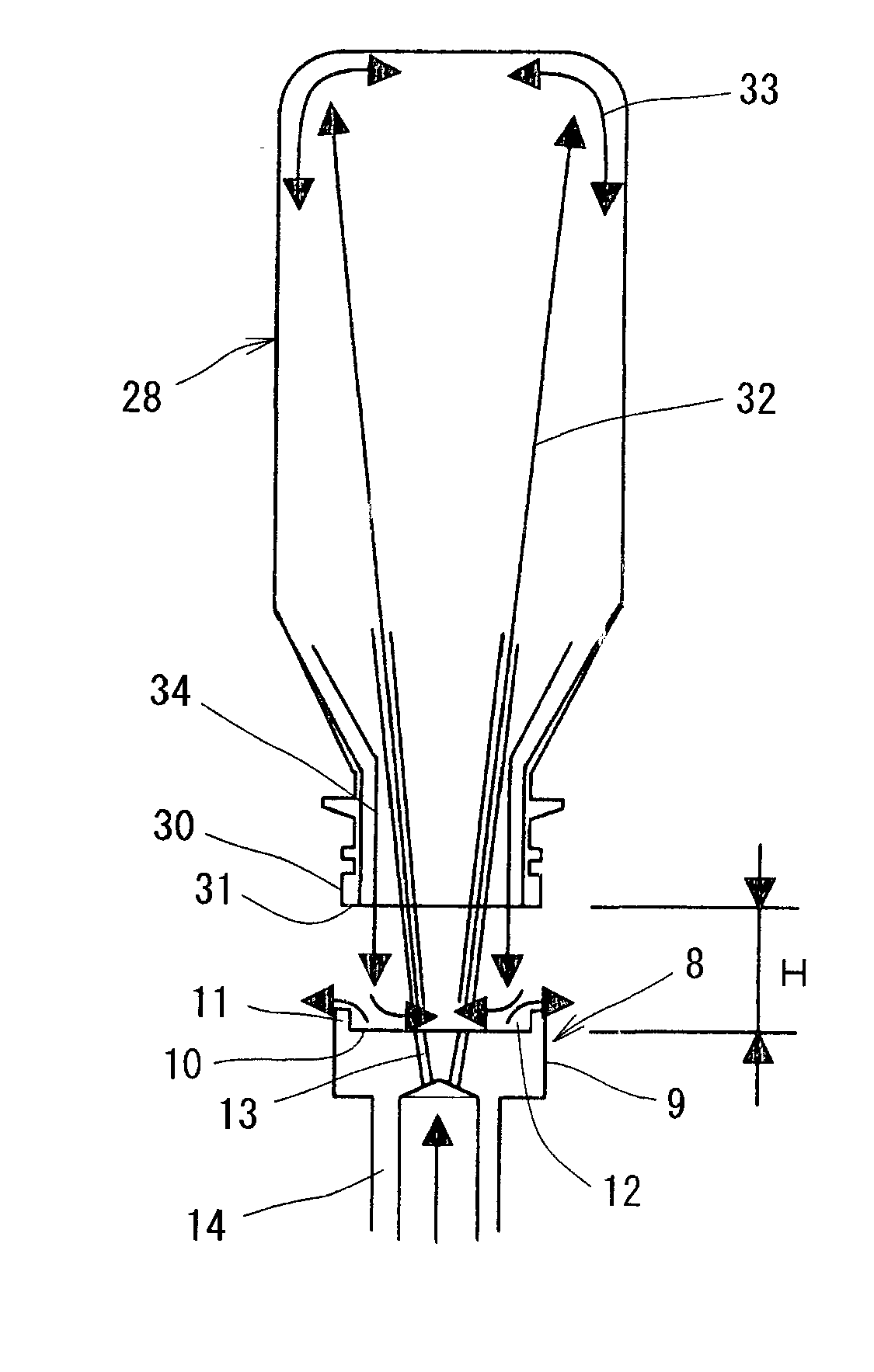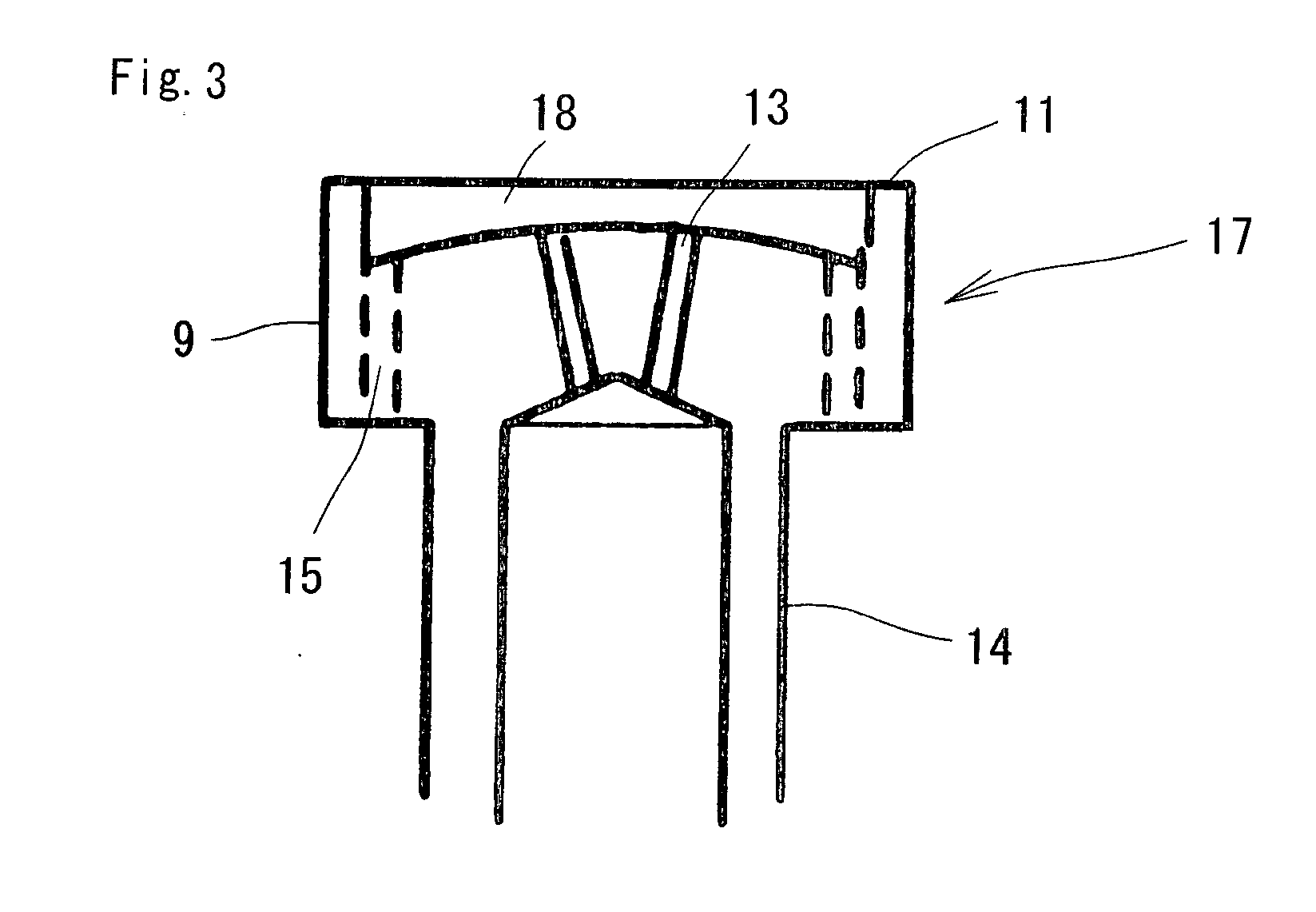Non-inserted nozzle for sterilizing or washing bottle container and method for sterilizing or washing inner surface of bottle container
a bottle container and nozzle technology, applied in the direction of disinfection, cleaning process and apparatus, cleaning using liquids, etc., can solve the problems of increasing the complexity and cost of the apparatus, the ratio of washing fluids to wetting the inner surface of the container is small, and the washing efficiency and sterilization efficiency can be improved. , the effect of reducing the number of times of sterilization
- Summary
- Abstract
- Description
- Claims
- Application Information
AI Technical Summary
Benefits of technology
Problems solved by technology
Method used
Image
Examples
example 1
[0035]Two types of nozzles, which are a non-inserted nozzle (referred to hereinbelow as “A-type nozzle”) employing the nozzle mouth of the configuration shown in FIG. 1 and a non-inserted nozzle (referred to hereinbelow as “B-type nozzle”) employing the nozzle mouth of the configuration shown in FIG. 2 and having a retention wall were used. The washing nozzle had four nozzle holes 6, 13 formed with a pitch of 5 mm. The inclination angle θ of the nozzle holes 6, 13 and hole diameter D were varied as shown in Table 1 and the time required to wet the entire surface of the inner wall of a bottle was measured. The bottle containers used for the test were round PET bottles with a capacity of 500 mL and angular bottles with a capacity of 2000 mL. The top surface of the socket section of the washing nozzle and bottle was set to 15 mm. The test was conducted at three flow rates: 4 L / min, 4.5 L / min, and 5 L / min. The wetting state was estimated by using red water for the washing fluid and visu...
example 2
[0037]A liquid discharge state was studied by changing the distance in the washing test in order to study the effect of the distance H between the liquid-retaining surface of the non-inserted nozzle and the lower end surface of the container mouth. The results are shown in Table 2. The results demonstrated that the distance clearly affected the state of the liquid flowing down in this test; thus, the liquid discharge ability was poor when the distance H was less than 4 mm, and the interference with the falling reflux liquid was facilitated when the distance was 40 mm or more. In the case of this test example, it was confirmed that the appropriate distance H was 5 to 35 mm. However, the optimum distance H differs depending on the bottle mouth diameter and the range of the distance H increases with the increase in the mouth diameter.
Non-Inserted Nozzle Used: B-Type Nozzle
[0038]Four nozzle holes, inclination angle θ=5.0°, nozzle diameter D=1.5 mm, height of retention wall 4 mm. Supplie...
example 3
[0040]In order to verify the juggling effect of the B-type nozzle provided with a retention recess on the liquid-retaining surface, the non-inserted nozzles in which the number of nozzle holes, hole diameter, and height of retention wall differed as shown in Table 3 were used, a test was conducted three times on each nozzle by changing the spraying flow rate, and the time required to wet the entire inner surface of the container was measured. The distance between the liquid-retaining surface and the top surface of bottle mouth was set to 15 mm in all cases. The supplied bottles were 500 mL round PET bottles. The results are shown in Table 3.
TABLE 3TIMEREQUIREDDISTANCETO WETNUMBERHOLELIQUIDBETWEENTHE ENTIRENOZZLEOFANGLEDIAMETERRETAININGBOTTLE ANDFLOW RATESURFACE (sec)NUMBERHOLESθ (°)D (mm)RECESS (mm)NOZZLE (mm)BOTTLE(L / min)(1)(2)(3)EVALUATION*B-345.01.5215500 mL,3.51.62.02.2◯round41.91.81.5◯4.51.41.21.7◯B-445.01.5415500 mL,32.63.42.4Xround3.51.52.11.8◯41.11.31.1⊚B-565.01.2415500 mL,4...
PUM
 Login to View More
Login to View More Abstract
Description
Claims
Application Information
 Login to View More
Login to View More - R&D
- Intellectual Property
- Life Sciences
- Materials
- Tech Scout
- Unparalleled Data Quality
- Higher Quality Content
- 60% Fewer Hallucinations
Browse by: Latest US Patents, China's latest patents, Technical Efficacy Thesaurus, Application Domain, Technology Topic, Popular Technical Reports.
© 2025 PatSnap. All rights reserved.Legal|Privacy policy|Modern Slavery Act Transparency Statement|Sitemap|About US| Contact US: help@patsnap.com



